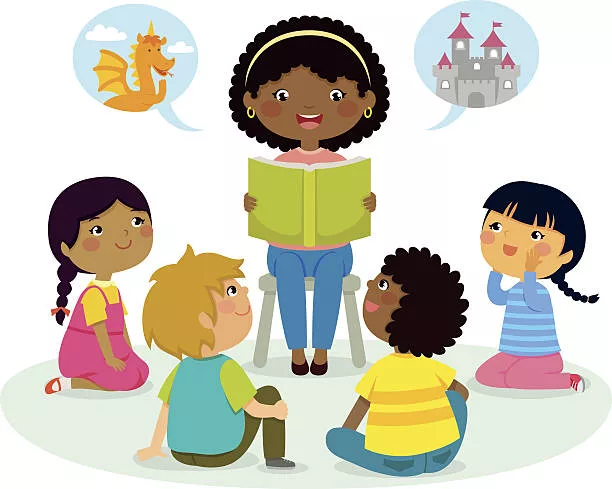12 Must-Read Moral Stories for Kids and Tips to Enhance Story Time
Narratives play a vital role in captivating your child’s attention, and some of the most vivid childhood memories often revolve around the stories you read or were told. Many of these tales likely carried valuable morals, a characteristic less prevalent in contemporary stories.
How wonderful would it be to pass down these cherished narratives to your own child? To help you begin this delightful journey, we’ve compiled a list of such stories that blend entertainment with meaningful life lessons.
This article presents a compilation of 12 moral stories for children in English, delving into the significance of how these narratives contribute to instilling essential moral values in your child.
Boost your child’s Vocabulary:
To begin, let’s explore the concept of a moral story. Essentially, a moral story is a narrative designed to impart crucial life lessons. Children derive enjoyment from stories with morals, gaining insights into handling aspects like rejection and overcoming fear.
Research indicates that these narratives play a pivotal role in shaping the moral reasoning of young children, influencing their understanding of essential values from an early age.
An added benefit is that introducing moral stories to your child at an early age not only imparts valuable life lessons but also contributes to their language development. Now, let’s dive into our curated list of moral stories for kids to kickstart this enriching journey!
12 Essential Moral Stories for Children:
Explore this compilation of inspiring short moral stories for kids, featuring tales from both India and around the globe.
Moral Stories from around the world:
1) The Golden Touch of Midas:

Once in a bygone era, there ruled a wealthy Greek monarch named Midas. His vast riches included an abundance of gold, and his most cherished possession was his beloved daughter.
One fateful day, Midas encountered an angel in distress. Ever compassionate, he extended his help, and in gratitude, the angel offered to grant him a single wish. Midas, driven by a desire for even greater wealth, wished that everything he touched would transform into gold. To his surprise, the wish was granted.
On his journey homeward, Midas excitedly touched various objects, turning rocks and plants into glistening gold. However, his elation took a tragic turn when, in a moment of enthusiasm, he embraced his daughter, and she, too, succumbed to the golden transformation.
Overwhelmed with grief and remorse, Midas realized the folly of his greed. Having learned a profound lesson, he beseeched the angel to rescind his ill-fated wish.
Moral of the story
Greed is not good for you. Be content and satisfied to lead a happy and fulfilling life
2) The Tortoise and the Hare:

In the realm of well-known tales, there exists a story featuring a hare and a tortoise—a classic fable highlighting the contrast between speed and steadiness.
The hare, renowned for its swift movements, and the tortoise, recognized for its unhurried pace, found themselves in a peculiar challenge. Driven by a desire to prove superiority, the hare proposed a race, a proposition the tortoise readily accepted.
As the race commenced, the hare effortlessly surged ahead, establishing a considerable lead. Convinced of victory and underestimating the tortoise, the overconfident hare opted to take a leisurely nap.
Meanwhile, the determined and unwavering tortoise steadily progressed toward the finish line. With resilience and dedication, the tortoise triumphed in the race, achieving a noteworthy victory marked by humility and devoid of arrogance.
Moral of the story:
When you work hard and persevere, you can achieve your goals. Slow and steady wins the race.
3) The Boy who cried wolf:

In a rural village, a farmer entrusted his son with the daily task of taking their flock of sheep out for grazing. However, as the boy diligently watched over the sheep, boredom crept in, leading him to seek some amusement.
In a mischievous move, he cried out, “Wolf! Wolf!” The alarmed villagers rushed to his aid, only to discover that it was a false alarm—a mere jest on the boy’s part. Incensed by the unnecessary commotion, the villagers scolded him for causing chaos and panic.
Undeterred by the consequences, the next day the boy repeated his ruse, again shouting “Wolf!” This time, the villagers, still irked by the previous incident, rushed to his aid only to find no real threat.
Regrettably, on the very same day, a genuine wolf appeared, posing a real danger to the sheep. The desperate boy cried out for help, but this time, the villagers, skeptical of another prank, chose not to respond. Tragically, the wolf terrorized the flock, underscoring the severe consequences of the boy’s earlier deceptive antics.
Moral of the story
Don’t play with people’s trust, when it matters the most, they won’t believe you.
4) The Three Little Pigs:

Sent out into the world by their mother to learn, three little pigs embarked on a journey of independence.
Each pig, driven by their work ethic, chose a distinct approach to building a house. The first pig, preferring ease over effort, constructed a house of straw, embracing a somewhat lazy approach. The second pig, displaying more diligence, opted for a house made of sticks.
In stark contrast, the third pig exemplified hard work and dedication by crafting a robust house of brick and stone, investing substantial effort into its construction.
When a menacing wolf arrived, he began his assault. With a forceful huff and puff, the house of straw succumbed to the wolf’s breath. The house of sticks met a similar fate with the wolf’s relentless blowing.
However, the determined wolf faced a formidable challenge with the house of bricks. Despite huffing and puffing incessantly, the resilient structure stood strong, and the wolf, eventually exhausted, conceded defeat and departed. The tale underscores the enduring value of hard work and the strength that comes from investing effort into one’s endeavors.
Moral of the story
Always work hard and it will pay off. Don’t try to take shortcuts to make things work.
5) The Fox and the Stork:

In a quaint tale, a Fox and a Stork crossed paths. Despite the Fox’s selfish nature, he extended an invitation to the Stork for dinner. Delighted by the gesture, the Stork graciously accepted and arrived punctually.
Upon entering the Fox’s abode, they settled at the table. To the Stork’s surprise, the Fox served soup in shallow bowls. While the Fox easily enjoyed his meal by licking up the soup, the Stork, hindered by her long beak, struggled to partake as the bowls were too shallow for her.
Undeterred by the Fox’s lack of hospitality, the following day, the Stork reciprocated the invitation, hosting the Fox for dinner. This time, she served soup in two narrow vases. As the Stork relished her meal, the Fox, faced with the challenge of the vases, left the dinner table hungry, realizing the consequences of his earlier selfishness. The tale conveys the timeless lesson of treating others as you would like to be treated.
Moral of the Story
Don’t be selfish because it will come back to you at some point
6) The Ant and the Grasshopper:

In a tale of contrasting personalities, the ant and the grasshopper were the best of friends. The grasshopper, carefree and musical, spent his days playing the guitar or indulging in long, leisurely naps. In stark contrast, the diligent ant toiled away, collecting food and diligently building his ant hill.
Despite the grasshopper’s occasional suggestions for the ant to take a break, the industrious ant remained steadfast, refusing to relent until his work was complete.
As winter descended, bringing cold days and colder nights, the ants found themselves diligently drying grains of corn. Weakened and hungry, the grasshopper approached the ant colony and humbly asked for a piece of corn. The ant, recalling the hard work throughout the summer, questioned why they should share their harvest with the grasshopper.
The grasshopper, realizing the consequences of his carefree ways, acknowledged his oversight. The story serves as a poignant reminder of the importance of hard work and preparation, especially when faced with the inevitable challenges that life may bring.
Moral of the Story
Make use of opportunity while you have it.
7) Be wise while counting:

In a day at Akbar’s court, a question perplexed everyone: “How many crows are there in the city?” None could provide an answer until Birbal stepped forward with a swift response, “Four thousand three hundred and twelve.” Intrigued, they questioned how he arrived at this precise number.
Birbal explained, “Simply send your man to count the crows. If the count is less than this number, it means some crows are visiting their families elsewhere. Conversely, if it exceeds this number, it implies that crows from outside are visiting their families here.” Akbar, delighted with Birbal’s clever solution, showered him with gifts in appreciation of his wit.
Moral of the story:
Sometimes you have to learn to think outside of the box.
8) The Monkey and the Crocodile:

Once upon a time, on the banks of a river, there was a monkey residing in a berry tree. One day, he noticed a tired and hungry crocodile beneath the tree. Out of kindness, the monkey shared some berries with the crocodile, and a friendship blossomed between them.
Grateful for the monkey’s generosity, the crocodile became a regular visitor, receiving daily offerings of berries. However, unbeknownst to the monkey, the crocodile’s wife harbored a sinister plan. She desired the monkey’s heart, revealing her wicked and cunning nature.
Disturbed by his wife’s request, the crocodile felt torn but decided to fulfill her wish to make her happy. Craftily, he informed the monkey that his wife had invited him for dinner, and he carried the monkey on his back across the river.
During the journey, the crocodile confided in the monkey about his wife’s malevolent intentions. Quick-witted, the monkey concocted a plan to save himself. He told the crocodile that he had left his heart on the berry tree and insisted on returning to retrieve it.
Once back on the tree, the monkey sternly addressed the crocodile, declaring, “I won’t come down; you betrayed my trust, and that signifies the end of our friendship.”
Moral of the story
Never betray someone who trusts you and choose your friends wisely.
9) The foolish thief:

A wealthy man approached Akbar’s court seeking Birbal’s assistance, suspecting one of his servants of theft. To unveil the truth, the ingenious Birbal devised a plan.
Birbal distributed sticks of equal length to all the merchant’s servants, informing them that the sticks would grow three inches overnight if they were innocent.
The following day, the servants gathered, sticks in hand, for Birbal’s scrutiny. Upon observation, Birbal noticed that one servant’s stick was three inches shorter than the others. With this revelation, Birbal astutely identified the thief.
The culprit had preemptively cut three inches off the stick, assuming it would grow back. This clever stratagem exposed the guilt of the thief and resolved the case.
Moral of the story
The truth will always come out one way or another so better to be truthful from the beginning.
10) The Brahmin’s dream:

In a solitary village lived a poor Brahmin, devoid of friends and family. Earning his livelihood through begging, he was notorious for his stinginess. His sustenance came from the alms he collected, which he stored in an earthen pot hanging beside his bed for easy access.
One day, he received an abundance of rice gruel, leaving an ample amount even after finishing his meal. That night, a vivid dream unfolded before him. In his dream, the pot overflowed with rice gruel, and he envisioned a prosperous future. He imagined selling the surplus food during a famine, earning silver that would eventually lead to the acquisition of a pair of goats. The goats, in turn, would multiply, creating a flourishing herd. This herd could be traded for buffaloes, providing milk for the production of dairy products. The sale of these products would yield more money.
With his newfound wealth, he envisioned marrying a wealthy woman, and together they would raise a son. In his dream, he saw himself lovingly scolding his son, teaching him life’s lessons. However, his dream took an unexpected turn when, in a fit of excitement, he grabbed a nearby stick and began swinging it in the air.
Lost in the dreamworld, he inadvertently struck the earthen pot, causing it to shatter and spilling its contents onto him. Startled, the Brahmin awoke, realizing that it was all just a dream. The shattered pot served as a stark reminder of the transient nature of his fanciful aspirations.
Moral of the story
One should not build castles in the air.
11) The Stork and the Crab:

On the banks of a fish pond resided an elderly stork who, too aged to catch fish, needed to devise a plan for sustenance. An ingenious idea struck him, and he stood in the water with a sorrowful expression. Seizing the opportunity, a curious crab approached and inquired about the stork’s apparent distress.
The stork, with a forlorn demeanor, conveyed, “I’ve heard rumors that this pond is on the brink of drying up, compelling me to seek refuge in another pond.” The compassionate crab, concerned for the well-being of the pond’s inhabitants, proposed a plan.
The stork agreed to transport a couple of fish in his beak, purportedly to relocate them to a safer pond. However, once far from the original pond’s sight, the stork consumed the fish himself. This deceitful act continued repeatedly.
When it was the crab’s turn to be transported, a dreadful realization struck as it peered down during flight. Instead of a new pond, all that met its gaze were scattered fish bones. Instantly comprehending the stork’s deception, the crab tightened its sharp claws around the stork’s throat. In a desperate struggle, the stork attempted to break free, but the crab clung tenaciously.
Ultimately, the stork succumbed, falling to the ground. The victorious crab, having secured justice, returned to the pond to share the tale with the other inhabitants, cautioning them about the treacherous stork’s ruse.
Moral of the story
Too much greed is bad for you and will only cause you harm
12) The Blue Jackal Story:

In the heart of the jungle, there lived a daring jackal with an adventurous spirit. Despite the presence of intimidating dogs in the nearby village, the jackal was drawn to the allure of food and frequently ventured into the village.
One day, as he approached a house, the echoing barks of a menacing gang of dogs sent shivers down his spine. Fearing for his safety, the jackal hastily retreated and inadvertently stumbled into a tub of blue dye. Now entirely covered in blue, he marveled at his transformed appearance, realizing that he could use this disguise to his advantage.
Feeling confident in his newfound identity, the blue jackal confidently returned to the jungle. The animals, taken aback by the unfamiliar creature, questioned who he was and why he had come.
With a sly grin, the blue jackal declared, “I have been sent by God himself to be your ruler. Henceforth, I shall be the king of the jungle, and all of you must serve me.”
Amid protests from the lion, the blue jackal asserted his authority, warning that disobedience would lead to the destruction of the entire jungle by God. Fearing for their lives and the safety of their home, the animals reluctantly agreed to serve the blue jackal.
Capitalizing on his newfound power, the blue jackal demanded copious amounts of food from the other animals, relishing in the abundance. In a twist of generosity, he distributed leftovers to his subjects, instructing them to provide fresh food daily.
To secure his deception, the blue jackal expelled a pack of jackals from the forest, recognizing the threat they posed to his secret. Pleased with his cunning strategy, the blue jackal reveled in the success of fooling the entire jungle and distanced himself from the city dogs that once frightened him.
However, his triumph was short-lived. One day, as a banned pack of jackals roamed the forest, their howls echoed through the trees. Inadvertently, the blue jackal, out of habit, joined in the howling. This momentary lapse exposed his true identity, leading the other animals to identify him as a jackal and ultimately leading to his demise.
Moral of the story:
Be true to yourself and don’t pretend to be someone you are not.
How to make story time more interesting for your kids?
Making story time more interesting for kids can enhance their enjoyment and engagement with the narrative. Here are some tips to make story time more enjoyable:
- Choose Age-Appropriate Books: Select books that match your child’s age and interests. Consider their preferences and favorite themes.
- Use Expressive Voices: Bring the characters to life by using different voices for each character. Use accents, pitch variations, and expressive tones to make the story more engaging.
- Interactive Reading: Encourage your child to participate by asking questions, predicting what might happen next, or discussing the story. This fosters comprehension and keeps them engaged.
- Add Props or Visual Aids: Use props or simple visual aids to complement the story. This could be as simple as showing pictures in the book or using small objects to represent characters or events.
- Act Out the Story: Act out parts of the story to make it more interactive. This can involve simple gestures, facial expressions, or even moving around the room to represent different scenes.
- Create a Cozy Reading Environment: Set up a comfortable and inviting reading space. Use soft pillows, blankets, or a special reading nook to create a cozy atmosphere.
- Explore Different Genres: Introduce a variety of genres to keep things interesting. Include fiction, non-fiction, poetry, and fairy tales to expose your child to different writing styles.
- Incorporate Technology: Use audiobooks, e-books, or interactive storytelling apps to add a tech-savvy twist to story time. Some apps also provide animations or sound effects that can enhance the experience.
- Connect Stories to Real Life: Relate the events in the story to your child’s own experiences. This helps them connect with the narrative and understand the relevance of the story.
- Encourage Creativity: After reading, encourage your child to draw, write, or act out their version of the story. This fosters creativity and reinforces comprehension.
- Celebrate Achievements: Praise your child for their engagement during story time. Acknowledge their questions, observations, or contributions to make the experience positive and rewarding.
- Be Consistent: Establish a routine for story time, whether it’s before bedtime or during a specific part of the day. Consistency helps create anticipation and makes it a cherished part of their daily routine.
Remember, the key is to make story time a joyful and interactive experience that nurtures your child’s love for reading and learning.










